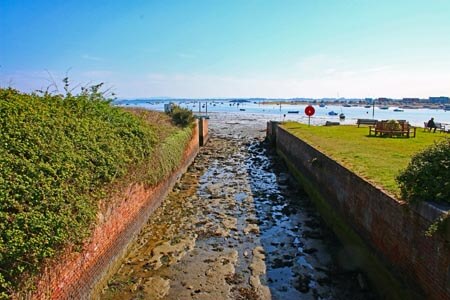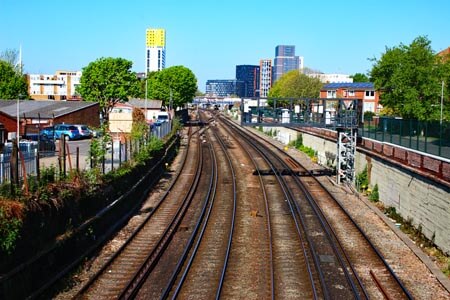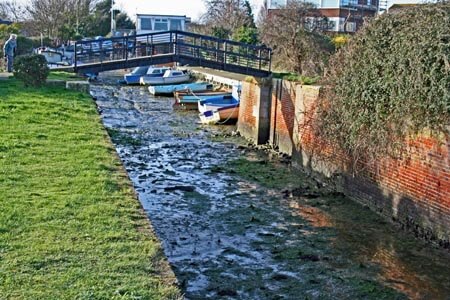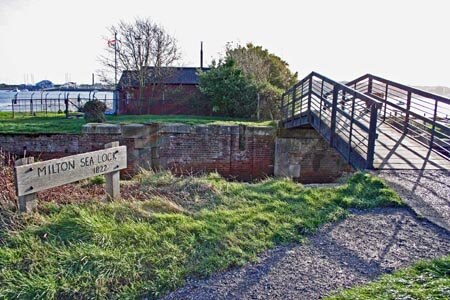The History of Portsmouth Canal

It's not obvious today, but if you look closely there are still signs of the Portsmouth Canal which was designed to connect Portsmouth to London, without the need to sail around the English Channel coast. During the early 19th century large amounts of goods were transported between London and the south coast ports by coasters.
As England was often at war with France it was feared that these trade routes could be easily disrupted by the French attacking from the sea, in addition the sailing vessels were often slow due to unfavourable wind conditions. The road system at this time was poor, so an inland waterway, linking London to Portsmouth was proposed.
An inland navigable waterway from the Thames at London to the south coast was first mentioned in 1585 in an Elizabethan Act of Parliament, but no progress was made.
John Rennie's Canal Proposal (1802)
n 1802 renowned canal engineer John Rennie proposed a plan for a 100 mile canal involving 41 locks vi Croydon, Merstham, Ifield, Crawley, Horsham, Arundel, Barnham and finally through Chichester Harbour and Langstone Harbour.
The projected costs were:
- £720,600 for a broad canal
- £571,600 for a narrow canal
- Projected revenue £100,000/year
Large estate owners along the proposed route objected to the canal running through their land and the plan was blocked.
Alternative Canal Plans
In 1811 an alternative plan was mooted to connect the River Wey and the River Arun with an 18 mile canal, this would enable boats to travel from the Thames, down the river Wey and connect across to the river Arun which meets the sea at Littlehampton on the south coast. In 1816 the Wey and Arun Canal was completed at a cost of £107,000. With this link completed the Portsmouth to Arundel canal link became more feasible.
The Portsmouth-Arundel Canal Project

A bill was passed in Parliament in 1817 allowing the Portsmouth Arundel Navigation to be built and, as laid down in the terms of the bill, a company was formed, this raised £101,250 for the construction work, the principal shareholder being Earl Egremont. George O'Brien Wyndham the 3rd Earl of Egremont was a major landowner who lived at Petworth House in Sussex. A steam tug which was used to tow barges across Chichester and Langstone Harbours to the Portsmouth Canal was named Egremont after the Earl.
Work started in August 1818 and opened on May 26 1823 with the navigation from Arundel, down the river Arun, through a new canal from Ford to Salterns Lock, passing north of Thorney Island and then through both Chichester and Langstone Harbours to Portsea Island.
The Portsmouth section of the canal was completed in September 1822 and was able to carry vessels of up to 150 tons. At the opening the steam tug Egremont towed several barges along the canal, carrying passengers and a band from the basin where Arundel Street is now along towards Milton. The full canal opened on May 26th 1823, the next day a group of boats travelled from Arundel and through the Portsmouth section approximately 20,000 people gathered to watch.
At Milton two sets of locks and a basin were constructed allowing access from the canal to Langstone Harbour when the tide was high, the basin allowed boats to moor until the tide was high and the locks could be opened. The remains of one lock can still be seen today, but the second lock which was opposite the Oyster House pub has been filled in and built over. To supply the water for the canal, a pump house was built at Milton which pumped water via well and pipe from the sea into the canal. This building can still be seen just off of Locksway Road (it's name a reference to the canal locks) today, it is labelled on the map and is now a private house.
Located at the inland end of the canal, roughly in the area where Arundel Street is today, at the Halfway Houses, the Portsea Basins were built to allow the loading and unloading of boats, this is how Arundel Street got its name.
Challenges and Decline

The Portsmouth to London waterway had a short and unprofitable history as the introduction of the railways and the development of steamships soon negated its purpose. Loads carried reflect this:
- 1823 = 1,900 tons transported
- 1824 = 3,650 tons transported
- 1840 = 402 tons transported
The whole project cost £125,000 to build, with the canal being opened in stages and the first stage opened on the 26th May 1823. The canal scheme in Portsmouth had many problems and trade never matched the levels predicted, limiting the income of the canal company. In 1824 only 3,650 tons of freight used the canal which was less than one twelfth of its projected usage. By 1830 the charges were lowered and so there was a slight pick up in usage. The charges to carry goods between Portsmouth and London were 3s 3d per ton for tallow, sugar, porter and hemp. All other goods was 11s 9½d per ton. By 1840 the amount of freight had crashed to just 402 tons making the canal unfeasible to support.
- 1841 – London to Brighton railway completed.
- 1847 – London to Chichester railway completed.
- 1855 – London to Portsmouth railway completed.
- 1855 – Hunston to Ford scetion of the canal closed.
A further problem was that salt water from Langstone Harbour which was used to fill the Portsea section of the canal, percolated down through the soil at the base of the canal contaminating the local well water supply. At the time well water was the primary source of drinking water for residents of Portsea Island.

Portsmouth Canal Legacy
The canal bed between Fratton Bridge and Portsmouth & Southsea Station was later used for railway tracks, and another section became Goldsmith Avenue.
Visible Reminders Today:
- Sea locks at Milton, near the Thatched House Pub
- Towpath Mead housing development in Milton
- Old Canal Inn pub in Milton
- Canal Walk street west of Fratton Station
Though short-lived, the Portsmouth Canal remains a fascinating chapter in the city's industrial and transport history, with traces still visible to this day.
The Navigators
From the late 18th century, large gangs of workmen moved around the country, digging canals with picks, shovels and wheelbarrows. Canals were called "inland navigations", so these builders came to be called "navigators", shortened by the public to "navvies" (often used as a term of abuse). The Navigators Pub which used to be be located on Isambard Brunel Road in Portsmouth, very close to Arundel Street, may have got it's name from these early canal builders.
Portsmouth Canal at Milton


